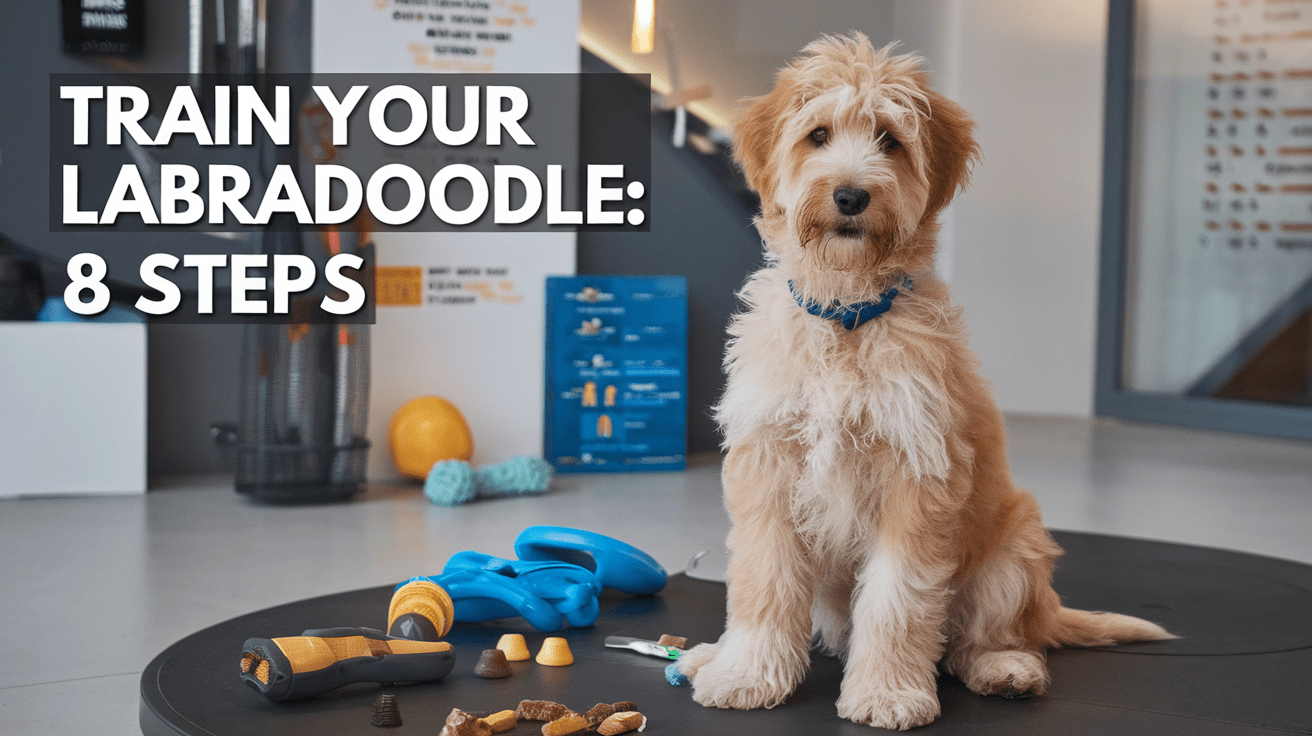How to Train a Labradoodle Puppy Key Takeaways
- ✓ Early Training: Begin training as early as 7-8 weeks old, keeping sessions short (3-5 minutes) and fun for optimal learning.
- ✓ Consistent Schedule: Establish a regular routine for potty breaks, training sessions, and meals to help your puppy learn faster.
- ✓ House Training: Use a properly sized crate and maintain a consistent potty schedule, with breaks every 2-3 hours for young puppies.
- ✓ Positive Reinforcement: Use treats, praise, and consistent commands to encourage good behavior and build a strong training foundation.
Welcome to your complete guide on how to train a Labradoodle puppy! As someone who’s guided countless Labradoodle owners through their puppy training journey, I can tell you these intelligent furballs are a joy to train. According to the American Kennel Club, puppies can begin learning basic commands as early as 7-8 weeks old, making early training crucial for success.
Your Labradoodle’s clever mix of Labrador and Poodle genes makes them highly trainable, but they can also be a bit stubborn (trust me, I’ve seen my fair share of puppy “selective hearing” moments in my veterinary practice!). Whether you’re struggling with potty training or wondering how to stop your pup from treating your fingers like chew toys, this comprehensive guide will walk you through everything you need to know about raising a well-behaved Labradoodle.
Let’s turn that energetic ball of fluff into a well-mannered family member – without losing the playful charm that makes Labradoodles so special!
Getting Started with Labradoodle Puppy Training
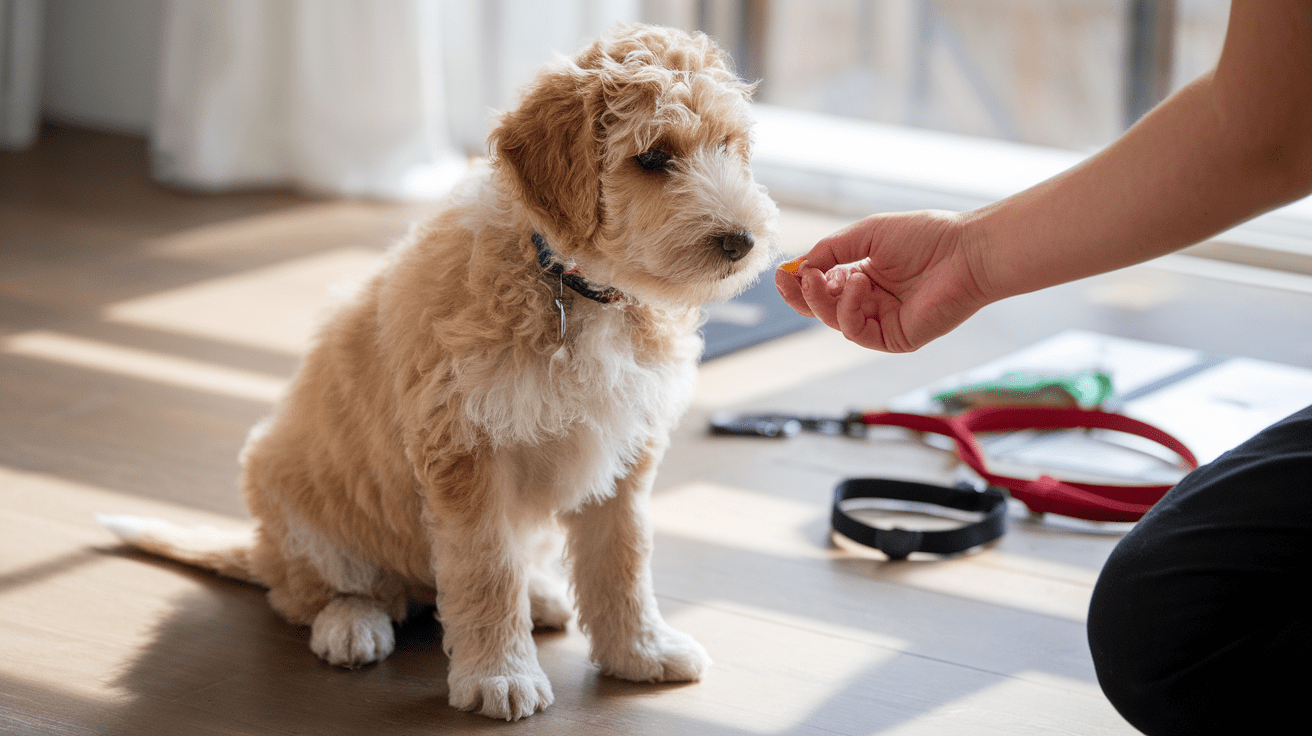
As a veterinarian who’s worked with hundreds of Labradoodle puppies, I can tell you that the key to successful training is getting started on the right foot. According to a study in Applied Animal Behaviour Science, puppies who receive structured training before 16 weeks of age show significantly better behavior patterns as adults.
When to Begin Training Your Labradoodle
The moment you bring your Labradoodle puppy home is when training begins – even if you don’t realize it! Just like children, puppies are constantly learning from their environment. I always tell my clients to think of their puppy’s mind as a sponge, soaking up every experience, both good and bad.
Your Labradoodle can start learning basic commands as early as 7-8 weeks old, but keep training sessions short and fun – think of it like teaching a toddler their ABCs. I remember working with a particularly energetic Labradoodle named Max who could only focus for about 3-4 minutes at first, but that’s completely normal!
Essential Training Supplies
To set yourself up for success, you’ll need:
• A properly sized collar and leash – nothing too heavy for your puppy
• High-value training treats – small, soft, and easily digestible
• A sturdy crate with comfortable bedding
• Puzzle toys for mental stimulation
• A clicker (if you plan to use clicker training)
Setting Up a Training Schedule
Consistency is your best friend when training a Labradoodle puppy. Create a daily routine that includes:
The most effective schedule follows your puppy’s natural rhythms. I typically recommend training sessions right after naps when your pup is alert but not overly excited. Keep sessions short – 3-5 minutes for young puppies, gradually increasing as their attention span grows.
Remember, your Labradoodle’s intelligence is both a blessing and a challenge. These clever pups can quickly learn commands, but they can also learn unwanted behaviors just as fast. That’s why establishing a positive and consistent training routine from day one is crucial for developing a well-behaved adult dog.
House Training Your Labradoodle Puppy
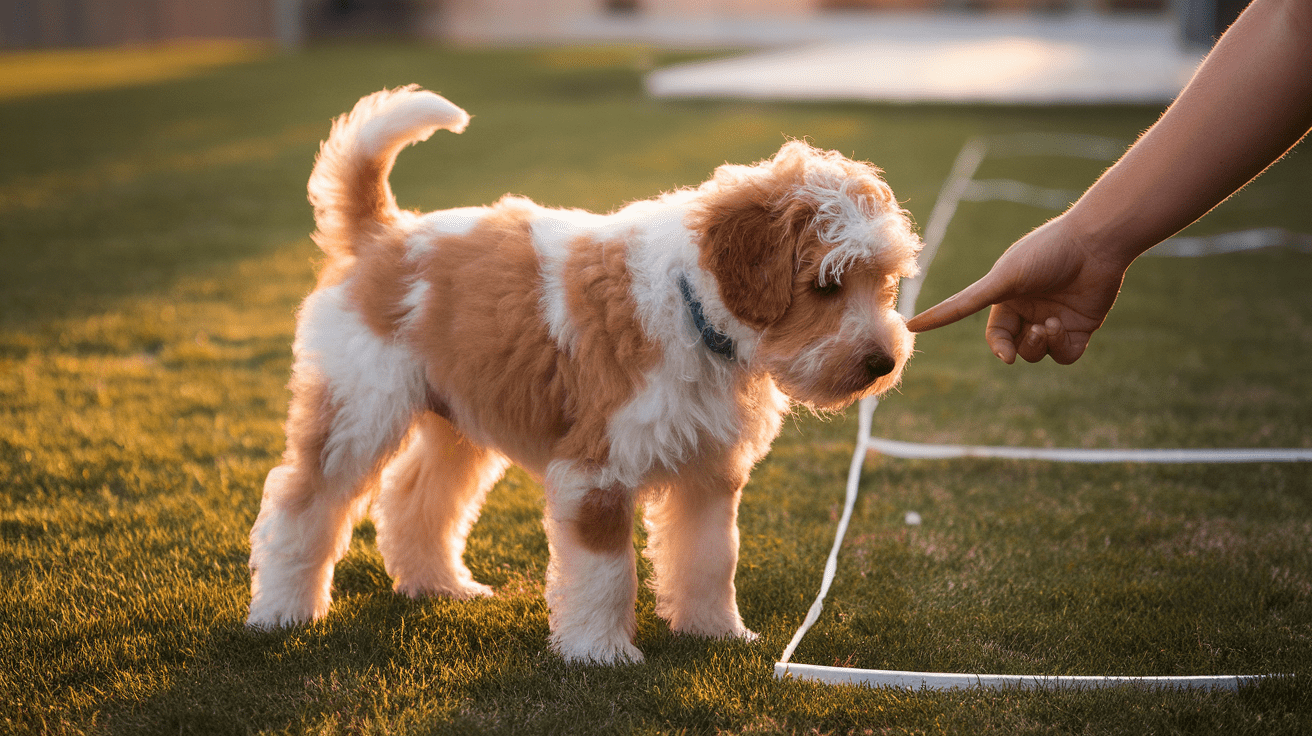
House training is often the first major challenge new Labradoodle owners face. According to a UC Davis Veterinary Medicine study, puppies who follow a consistent potty training schedule are typically fully house trained 2-3 months faster than those without a routine.
Establishing a Potty Routine
Your Labradoodle puppy needs to go potty at predictable times: after meals, naps, and playtime. Think of their bladder control like an hourglass – when it’s full, it needs to be emptied! I’ve found that young puppies typically need bathroom breaks every 2-3 hours during the day.
Create a designated potty spot in your yard. Your puppy’s keen sense of smell will help them recognize their bathroom area, making training more efficient. Always use a specific phrase like “go potty” and reward success with treats and praise – I had a client whose Labradoodle learned to ring a bell by the door when they needed to go out!
Crate Training Basics
A properly sized crate is your secret weapon in house training. Your Labradoodle should have just enough room to stand, turn around, and lie down. Too much space might encourage them to use one corner as a bathroom.
The crate should be their safe haven, not a punishment zone. Make it cozy with comfortable bedding and toys. Remember, puppies can typically hold their bladder for their age in months plus one – so a 3-month-old puppy can usually last 4 hours maximum.
Dealing with Accidents
Accidents happen – it’s part of the learning process! When they do:
• Never punish your puppy – this can create anxiety about eliminating
• Clean thoroughly with enzymatic cleaners to remove all traces of odor
• Catch them in the act? Calmly interrupt and redirect to the proper spot
• Keep track of accidents to identify patterns in timing or location
Prevention is better than cleanup – I always remind my clients to watch for telltale signs like sniffing, circling, or whining. These are your puppy’s way of saying, “I need to go!” The key to successful house training is patience, consistency, and positive reinforcement. Remember, every Labradoodle learns at their own pace, but with dedication, they’ll get there!
Basic Commands and Obedience Training
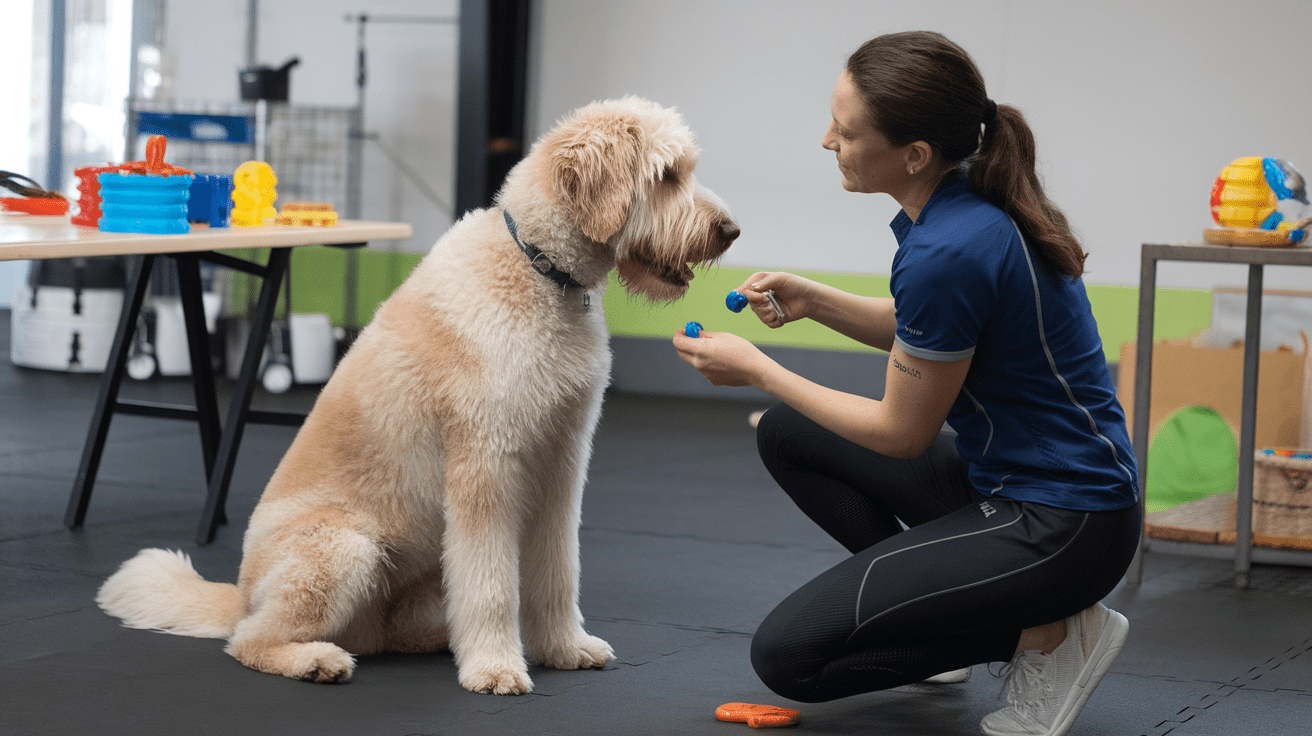
Teaching your Labradoodle basic commands is like building blocks for their education. According to a study in Frontiers in Veterinary Science, dogs who master basic obedience commands by 6 months of age are 80% less likely to develop behavioral problems later in life.
Teaching Sit, Stay, and Come
Start with the foundation commands: sit, stay, and come. These aren’t just party tricks – they’re crucial safety tools. I once treated a Labradoodle who avoided a car accident because his “stay” command was rock solid!
For teaching “sit”:
• Hold a treat above their nose
• Slowly move it back over their head
• As their head tilts up, their bottom naturally lowers
• Mark the behavior with a “yes” or clicker
• Reward immediately
Remember to keep training sessions short and sweet – about 5-10 minutes, 2-3 times daily. Your Labradoodle’s attention span is like a battery that needs frequent recharging!
Leash Training Techniques
Leash training can be challenging with energetic Labradoodles. The key is to make yourself more interesting than distractions. Use the “stop and go” technique – stop walking when they pull, and only continue when the leash is loose.
Think of leash training like a dance – you’re teaching your puppy to follow your lead. Start in low-distraction areas and gradually work up to more challenging environments. I always tell my clients to practice in their backyard before hitting busy sidewalks.
Addressing Jumping and Biting
Labradoodle puppies often express excitement through jumping and playful biting. While adorable at 8 weeks, it’s not so cute in a full-grown dog. To curb these behaviors:
• Turn away immediately when they jump
• Only give attention when all four paws are on the floor
• Redirect biting to appropriate toys
• Use a sharp “ouch!” when they bite too hard
One effective technique I’ve used is the “timeout method” – briefly removing yourself from play when your puppy gets too rough. It’s like teaching them that gentle play continues, rough play ends. Most Labradoodles catch on quickly because they’re so eager to please and maintain social interaction.
Remember, your puppy isn’t being “bad” – they’re learning how to interact appropriately. Consistency and positive reinforcement are your best tools for shaping good behavior. Every correction should be followed by an opportunity to succeed, making training a rewarding experience for both you and your furry friend.
Socialization and Behavioral Training
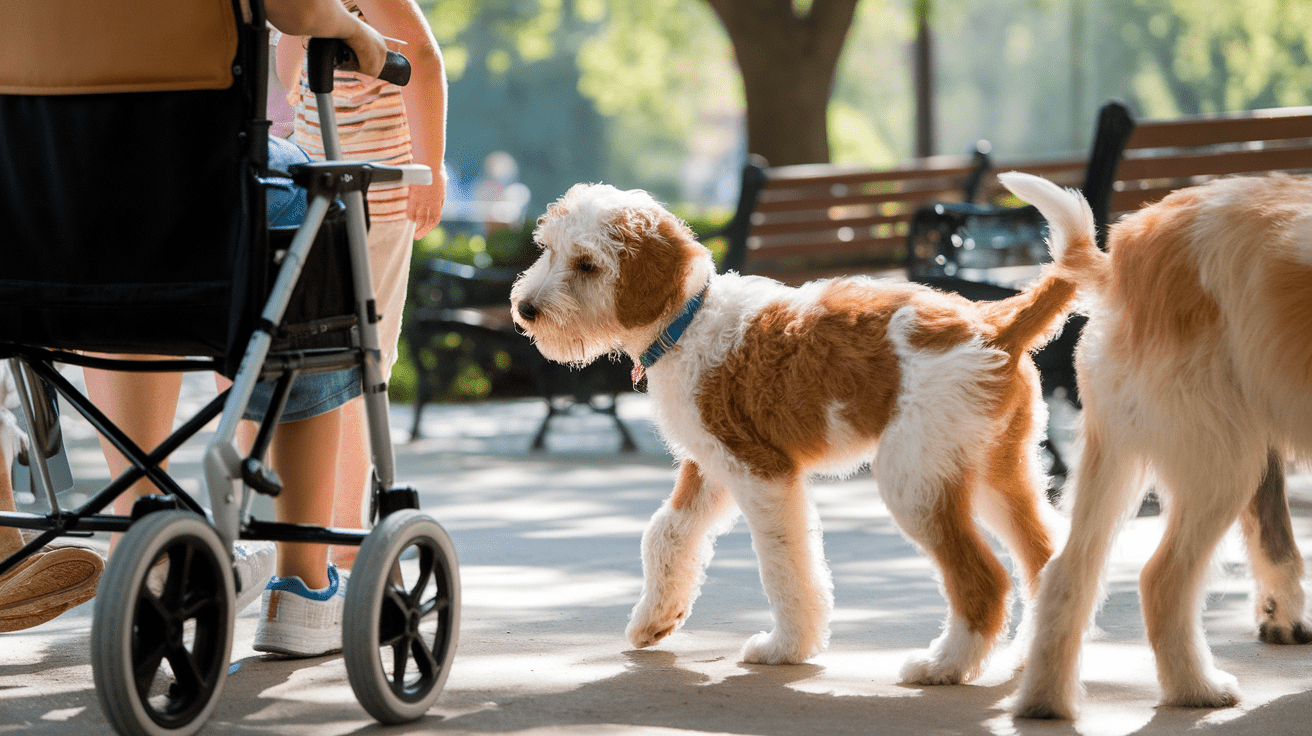
Proper socialization during your Labradoodle’s critical development period is essential for raising a confident, well-adjusted dog. According to a study in Applied Animal Behaviour Science, puppies who receive comprehensive socialization before 16 weeks of age are 72% less likely to develop fear-based behaviors in adulthood.
Introducing Your Puppy to New Environments
Think of socialization like building your puppy’s life experience portfolio. Every positive encounter adds to their confidence. I recently worked with a Labradoodle puppy who was initially scared of wooden floors – we turned it into a game with treats, and within a week, he was confidently prancing across them!
Create a socialization checklist including:
• Different walking surfaces (grass, concrete, gravel)
• Various sounds (traffic, vacuum cleaner, doorbell)
• Different weather conditions
• Various objects (umbrellas, bicycles, strollers)
Always let your puppy explore at their own pace. Forced interactions can create negative associations that are hard to overcome later.
Meeting Other Dogs and People
Labradoodles are naturally social creatures, but they need to learn proper greeting etiquette. Arrange controlled meetups with vaccinated, friendly dogs. Start with calm, well-mannered dogs who can teach your puppy appropriate social skills.
When meeting new people, teach your puppy to greet politely. I use the “four on the floor” rule – attention and treats only come when all paws are on the ground. This prevents jumping habits from forming.
Remember to expose your puppy to people of different:
• Ages (especially children)
• Appearances (people with hats, beards, glasses)
• Sizes and heights
• Mobility aids (wheelchairs, crutches)
Managing Separation Anxiety
Labradoodles can be prone to separation anxiety due to their strong human bonds. Start with brief departures and gradually increase duration. I recommend leaving your puppy with a special toy or frozen Kong that’s only available when you’re gone – it creates a positive association with alone time.
Practice the “departure routine” without actually leaving: pick up keys, put on coat, then sit down. This helps desensitize your puppy to these anxiety triggers. One of my clients used calming music specifically for dogs, and it worked wonders for their anxious Labradoodle!
The key to successful socialization is making each new experience positive and controlled. Think of it as building your puppy’s emotional resilience, one happy encounter at a time. Remember, a well-socialized Labradoodle puppy grows into a confident, adaptable adult dog who can handle life’s challenges with ease.
Advanced Training and Mental Stimulation
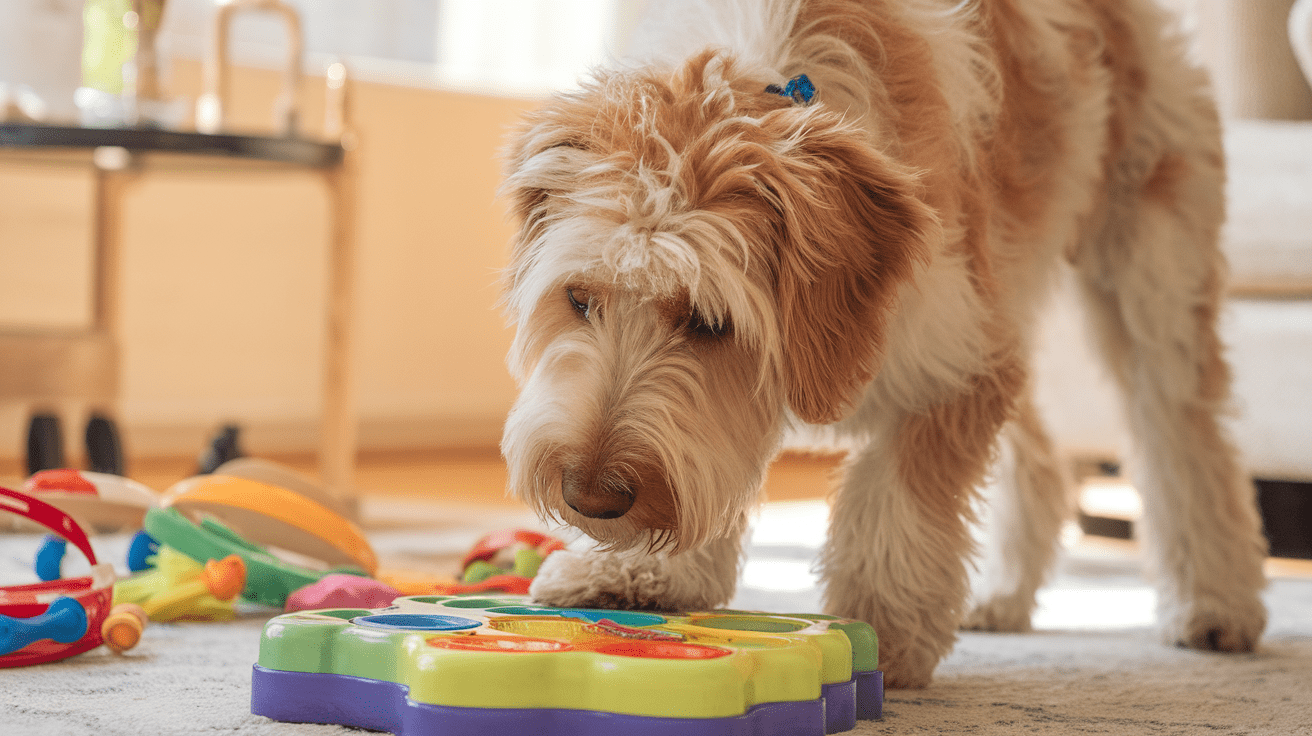
Once your Labradoodle has mastered the basics, it’s time to challenge their intelligent mind! According to a recent study in Applied Animal Behaviour Science, dogs who engage in regular mental stimulation activities show 45% fewer destructive behaviors and better cognitive function as they age.
Teaching Complex Commands
Labradoodles thrive on mental challenges. Build upon basic commands by teaching more complex behaviors like “roll over,” “play dead,” or “bring specific toys.” I recently worked with a Labradoodle who learned to differentiate between 12 different toy names – their learning potential is truly remarkable!
Advanced training should include:
• Chain commands (combining multiple commands)
• Distance work (following commands from afar)
• Hand signals alongside verbal cues
• Task-specific training (like retrieving mail or closing doors)
Remember to break down complex behaviors into smaller, manageable steps. Think of it like building a pyramid – each new skill rests on the foundation of previously learned commands.
Interactive Games and Puzzles
Mental stimulation is just as important as physical exercise for your Labradoodle. Their problem-solving abilities need regular workouts! I often recommend:
• Treat-dispensing puzzle toys
• Hide-and-seek games with toys or treats
• Nose work activities
• Interactive training games
One of my favorite techniques is the “shell game” – hiding treats under cups and letting your dog figure out which cup contains the reward. It’s amazing to watch their deductive reasoning skills develop!
Ongoing Training Tips and Maintenance
Training isn’t a destination; it’s a journey that continues throughout your Labradoodle’s life. Keep sessions fresh and engaging by:
• Rotating through different training activities
• Gradually increasing difficulty levels
• Practicing in new environments
• Incorporating training into daily routines
Think of maintaining your dog’s training like tending a garden – it needs regular attention to flourish. I always tell my clients to spend at least 15 minutes daily on some form of mental enrichment activity.
Remember, an intelligent breed like the Labradoodle needs both physical exercise and mental challenges to stay happy and well-behaved. The effort you put into advanced training now will reward you with a well-rounded, mentally sharp companion for years to come!
Frequently Asked Questions About Training a Labradoodle Puppy
Final Thoughts on Labradoodle Training
Training your Labradoodle puppy requires patience, consistency, and dedication, but the rewards are absolutely worth it! Remember that every puppy learns at their own pace, and what works for one might not work for another. The key is to maintain a positive training environment while staying consistent with your commands and expectations. From my years of veterinary experience, I’ve seen that Labradoodles who receive proper training and socialization in their early months grow into exceptional family companions. Keep training sessions fun, maintain clear boundaries, and celebrate small victories along the way. With their unique blend of intelligence and eagerness to please, your Labradoodle has the potential to become not just a well-behaved pet, but a cherished family member who brings joy and companionship for years to come.
For those seeking an even more comprehensive approach to training their Labradoodle, our detailed Proven Labradoodle Training Guide offers an in-depth look at mastering 15 essential skills. This expertly-crafted resource complements the fundamentals covered here and provides advanced techniques, troubleshooting tips, and milestone markers to ensure your Labradoodle reaches their full potential. Whether you’re dealing with specific behavioral challenges or aiming to advance your pup’s training, this guide serves as an invaluable reference for every stage of your Labradoodle’s development.

